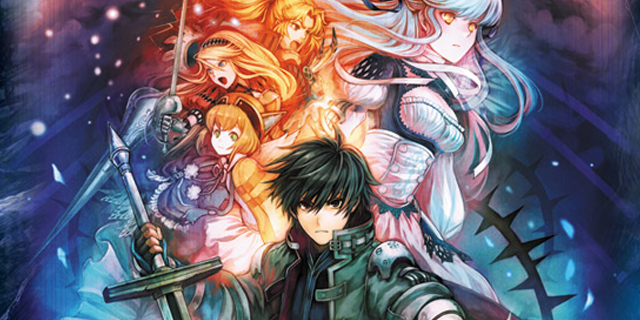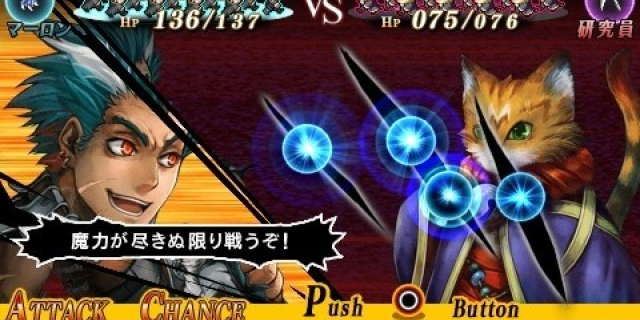
Every once in a while, a game comes out over here that by all rights should never have happened, either because of the genre, the subject, the timing or the console. Generation of Chaos: Pandora’s Reflection is one of those games. As a title in a niche genre released on an obsolete, mostly-dead system, it’s not a localization you would ever expect to see. Like most games that fall into this category though, it’s fairly good, and I’m glad it arrived.
Pandora’s Reflection takes place in a desolate world blighted with ashen rain, a poisonous rainfall that kills anything exposed to it for too long. The story revolves around a young alchemist named Claude and his sister, Yuri, who bears a butterfly shaped wound on her neck that is somehow related to the ashen rain. In their quest for medicine and a way to heal her, they quickly become embroiled in a larger conflict that could change the fate of the world, for better or worse.
This is the third game in the Generation of Chaos series to make its way over here, though the gameplay is completely different than in previous entries. While still a tactical RPG, this game is focused on small-scale battles involving up to five units at a time per side rather than the massive battles in previous titles. Conflicts are a real-time affair, with units moving around on a map at varying speeds depending on their class and the terrain. For instance, warriors are quicker on mountains and hills than others, while mermaids can outswim anyone. Spread across each map are various strategic points, villages and sometimes artillery. If you take control of more strategy points you can dispatch more units, while villages either allow more units or simply converse with you, sometimes giving you an item. Artillery will shoot projectiles across the map, and if controlled by the enemy, can cause lots of damage if you don’t avoid them.

Battles themselves are actually single attack instances in which each unit gets one attack, with whichever one is fastest on that terrain going first most of the time. Attacks actually have a slight rhythm aspect to them, with each different weapon type using a different pattern of button presses to hit. Successfully completing a rhythm doesn’t increase the amount of damage an attack does, but it does enable a secondary attack effect called “Attack Chance.” Depending on how accurate you were, allies within a certain radius of that enemy can join in with bonus attacks to further increase the damage done. If you manage to get five attacks in, an ultimate move is launched, dealing damage to every enemy on the battlefield. The weapons themselves operate on a rock-paper-scissors effectiveness style, though with five different weapon types.
Eventually, you will gain the ability to summon creatures that can impact the entire field, whether it be a summon that heals your entire squad, stuns all your enemies or even just hurts any units in a specific area or terrain type.
Outside of battle, the game is very simple. It consists of a menu where you can equip units, upgrade units or weapons, heal them, grind in free battles or continue the story. Each unit can hold a single item and two or three weapons, most can equip multiple types of weapons which allows more strategy in weapon selection in battle. Upgrading and healing us done via alchemy points, which are earned through battle instead of money. Weapons can all be upgraded with these points into more powerful versions, the cost increasing each time, though you can also use them to give extra experience to units if they need a level boost.
Most of the game consists of battles from an overhead view or of story scene stills between battles. The graphics during both do their job adequately, but the character portraits are fairly detailed and look quite nice. NISA chose not to do any English voice overs, but in the case of small, low-budget titles like this one, that’s generally a positive. The Japanese voices work well, and can be turned off if desired. There’s also just about no load times to wait through at any point in the game, which is a huge plus.
Really, the only complaint I have about Pandora’s Reflection is that, despite having an entertaining and varied cast of characters, their development doesn’t really go very far. Most of them never progress past the usual JRPG stereotypes that they initially embody. I’ve heard complaints about the streamlining and simplicity of the game itself, but games don’t have to be complex affairs to be enjoyable, and I quite enjoy it on the odd occasion I can play an RPG without a long tutorial or learning curve.
If you’ve been looking for a new game that feels like Ogre Battle, or if you just find yourself wanting a new RPG for your PSP or Vita, Generation of Chaos: Pandora’s Reflection is an appealing option.
Pros: Combat like old-style Ogre Battle with a twist, streamlined design
Cons: Not much character development



















